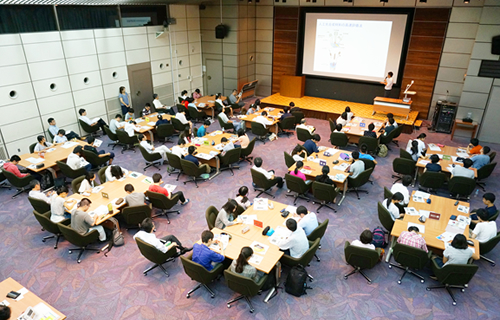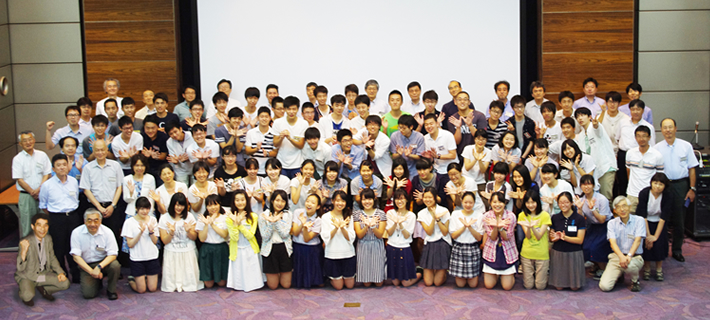Tokyo Tech's 13th education camp for high school students
Since 2004, Tokyo Tech has been offering opportunities for high school students to experience university-level education at the Summer Challenge, a unique three-day-two-night event carefully prepared by Tokyo Tech faculty.
From August 2 to 4, Summer Challenge 2016 brought together 64 high school seniors — 33 boys and 31 girls — from schools in the Tokyo metropolitan area. The youngsters gathered in Ranzan, Saitama Prefecture to exercise their creativity and group work skills through seven intellectual challenges, which aim to spark the interest of potential future STI leaders. This year, activities include an outdoor sketch experience and an independent research challenge, as well as a shuffle of groups midway through the event to ensure a more diverse exchange of views.
Outline of Summer Challenge 2016
- Dates:August 2 to 4, 2016
- Place:National Women's Education Center of Japan in Ranzan Town, Saitama Prefecture
- Number of participating students:64
Tokyo Tech High School of Science and Technology:36
Ochanomizu University Senior High School:9
Tokyo Gakugei University Senior High School:10
Other high schools:9
- Number of participating staff:51
Tokyo Tech faculty:26
High school teachers:15 (from 9 high schools)
Administrative staff:10
- Total number of participants:115
Challenge 1: Column land
Professor Kyoko Yamamuro
Department of Industrial Engineering and Economics, School of Engineering
Summer Challenge 2016 kicked off with Column Land, a popular Tokyo Tech class and effective ice-breaker where students evaluate short anonymous pieces of writing prepared in advance by all participants. This year's topic was "blue." Some essays described the blue skies, while others referred to childhood memories. An original text about a blue sports drink took first prize. Professor Yamamuro's approach was again successful in highlighting the individuality of each student while getting everyone more acquainted with each other.
High school teacher's comment:
An engaging ice-breaker that highlighted the creativity of each of the students.
Challenge 2: Architects — Always designing for someone special
Professor Yoshiharu Tsukamoto
Department of Architecture and Building Engineering, School of Environment and Society
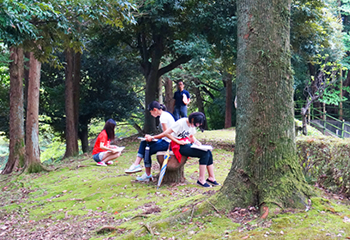
Challenge 2: Outdoor sketching activity
"Go out and sketch a Japanese garden, we will meet back here in 20 minutes to see how everyone did." Professor Tsukamoto's challenge began with a difficult task. As the students returned, the unreasonable requests continued. "OK, now design a room which looks out at the scenery you just sketched. You have 10 minutes." Despite the moans and groans from the students, the results were great examples of flexibility of the young mind. Ideas included a garden path that extends right through the room, and a window placed close to the floor so young children can enjoy the view.
High school teacher's comment:
A challenge that took everyone by surprise, turning students' weaknesses into strengths.
Challenges 3 and 4: Free research — Uncovering the secrets of cleaning products
Associate Professor Mitsutoshi Ueda
Professor Kazuo Shinozaki
Department of Materials Science and Engineering, School of Materials and Chemical Technology
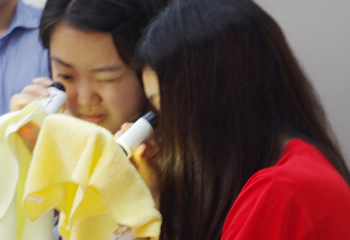
Utilizing microscopes in Challenges 3 and 4
This was an extended challenge that started in the evening of Day One and ended the following morning. As the students entered the activity hall after dinner, they were greeted by a line-up of daily cleaning products: sponges, cloths, and cleaning sprays.
Unlike the disassembly challenges in previous years, during which students took apart various items to analyze their individual components, this year's challenge encouraged a more active, independent research approach. By observing different types of sponges and cloths under the microscope, and carrying out experiments to compare absorption power and other characteristics, students were asked to compare different products and specifically describe why they are effective. Students presented their findings in presentation form on Day Two.
High school teacher's comment:
It was very refreshing to see students introduced to the first stages of research and investigate in more depth the products they were presented with.
Challenge 5: Accelerating the discovery of unknown substances with a combinatorial chemistry approach
Professor Akira Ohtomo
Department of Chemical Science and Engineering, School of Materials and Chemical Technology
How would you like it if you could freely combine molecules and create new substances that do not exist on Earth? Well, with this method, you can! In Challenge 5, students were introduced to combinatorial chemistry technology, which allows the simultaneous synthesis and rapid evaluation of large amounts of materials. With parallel synthesis and high speed at their disposal, students were asked to apply these to elucidate something around them.
Many responses involved "flavor" and "art." Using a new method to grasp something that was not quantifiable, many students also felt this challenge was the gateway to something extremely complex.
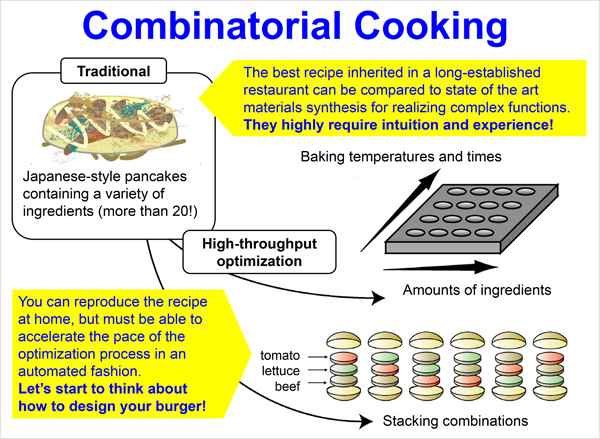
Combinatorics in cooking
High school teacher's comment:
I was surprised to see how flexibly the students approached such a difficult topic.
Challenge 6: Shopping for gravitational waves
Associate Professor Kentaro Somiya
Department of Physics, School of Science
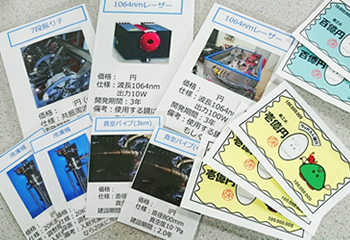
Challenge 6: Building a gravitational wave detector
The aim of this challenge was to introduce students to the enormity of certain science projects, in this case the development of a gravitational wave detector. Each group was first given 15 billion yen courtesy of the Bank of Tokyo Tech Challenge.
"Will you build it above or below ground? Opting for the latter might eat up money and time, but at least you will have a bigger black hole," the facilitator forecasted. Detector mirrors can be fused silica, sapphire, or silicon. Sapphire will be more resistant to heat, but silicon will provide more stability. After selecting systems engineers from their teams to take charge of the mirrors and anti-vibration aspects, and delegating tasks to appropriate team members, students spent the remainder of the summer night putting together equipment that would shed light on this elusive phenomenon of the cosmos, as suggested by Einstein 100 years ago.
High school teacher's comment:
While being a timely introduction to the hot topic of gravitational waves, the challenge also taught students how to manage a budget.
Challenge 7: Bacteria — The world's tiny giants
Associate Professor Takuji Yamada
Department of Life Science and Technology, School of Life Science and Technology
Those amazing bacteria. They are everywhere, making up over half of the Earth's biomass, and yet 99 percent of them have never been cultured or characterized. So what do we really know? We can now extract DNA from the ground, input the gene sequences into a computer, and estimate the types and amounts of bacteria around us.
With the help of bacteria during the final challenge, students were invited into the world of bioinformatics. They were shown the massive amounts of data that can be gathered as a result of this revolutionary breakthrough. So what should and can we do with this information? The final challenge highlighted the important of identifying a clear purpose for research, as well as acknowledging the potential ethical issues that may arise.
High school teacher's comment:
Students were shown how new technological developments lead to new fields of research and business opportunities.
. Any information published on this site will be valid in relation to Science Tokyo.






